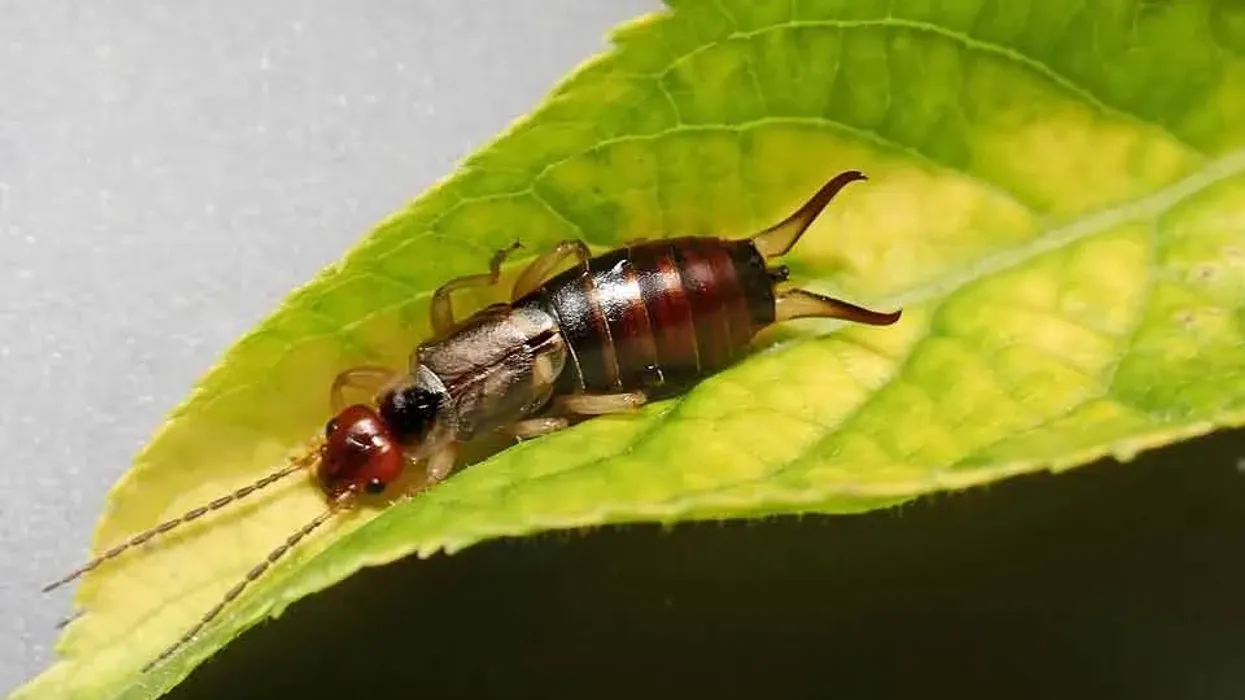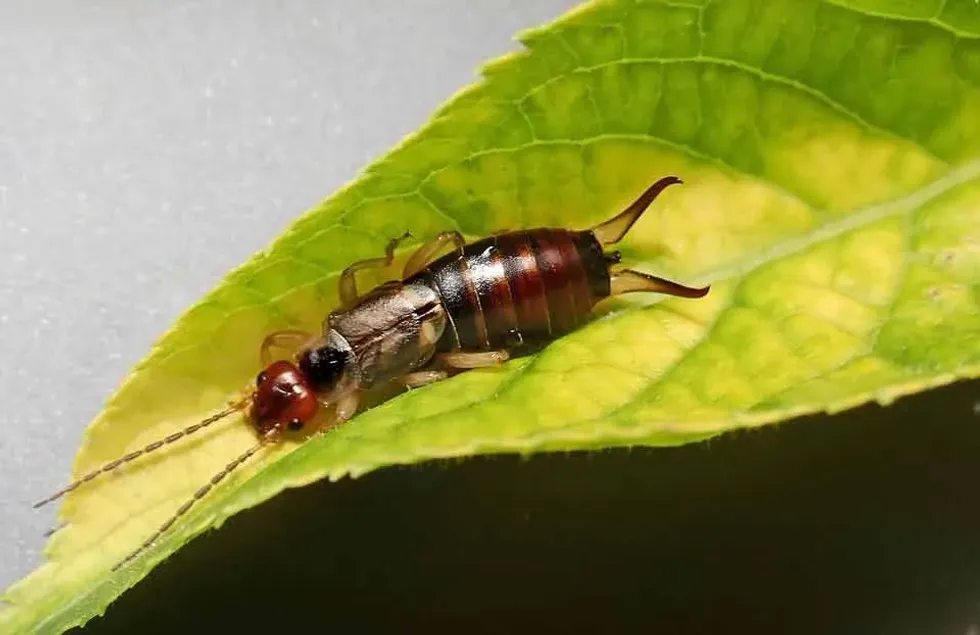Earwigs (Forficula auricularia) are weird-looking small creatures that do not cause much harm but are considered a nuisance, producing a foul smell. They are also known as pincher bugs or European earwigs.
Even though earwigs have pincers on the back of their abdomen, they are not poisonous or have venom. They are usually found in wet, dark areas and often found in houses and gardens in search of food and prey.
It is believed there is around 2000 different species of earwigs around the world.
Earlier the pincher bug was also known as 'bug in ear' due to the myth that these nymphs can reside inside the ear canal of a human while feeding on the brain and laying piles of eggs. But later on this belief was dispelled.
They use their pincers to capture their prey and feast on it. Even though earwigs have wings, they do not fly and rather roam around using their feet. If you find this article on earwigs (or ear wig) interesting, then do read our articles on ground beetle and centipede as well.
Earwig Interesting Facts
What type of animal is an earwig?
An earwig is a kind of an insect that feeds on other small insects and decaying plants and animals. There are around twenty-two varied kinds of earwigs found in America, and it is believed that there are around 1000 more types around the world.
What class of animal does an earwig belong to?
Earwigs belong to the class of Insecta and have a species of Arthropoda.
How many earwigs are there in the world?
It is almost impossible to calculate or tell how many earwigs there are around the world. But they are very common insects found everywhere, especially in wet and dark areas, including cracks and crevices in houses and piles of leaves in gardens.
Where does an earwig live?
A pincher bug is basically an odd looking insect that is characterized by his sharp pinchers and delicate wings which can be used for defense against their predators. These types of creatures prefer to live in dark and wet areas.
They usually come out in the dark at night in search of food.
Earwigs are weird-looking nocturnal creatures that prefer moist and small crevices during the day and come out in the dark. This insect also prefers wet and moist places such as gardens and houses in search of food and likes moist and wet grasslands as well as woodlands.
What is an earwig's habitat?
Earwigs are very common creatures that are found all over the world except in Antarctica. They usually find places that are dark, moist and warm in order to find food, lay their eggs and survive.
Who do earwigs live with?
These pests are considered semi-social creatures that may be found in groups. They do not form groups intentionally but are gathered and attracted by plants and animals. They prefer to live outdoors in dark and moist areas such as under piles of leaves or piles of compost or any other form of vegetation.
How long does an earwig live?
These weird looking insects, that have a six legs and a flat elongated body, are known to have an average life span of one year from the time of hatching.
How do they reproduce?
Female earwig has the option to choose the male she wants to mate with. They basically reproduce by laying eggs which the female earwig carries around with her until she finds a suitable place to lay them.
Their mating season is between the fall and early winter months. A female earwig is known to lay an average of 50 eggs at once.
The mother will stay with the eggs till they hatch, till the first molt. Thereafter, the nymphs are free to roam around as they are not known to use their wings.
What is their conservation status?
Even though earwigs have an average life span of one year, they are far from being extinct. They have a fast reproducing cycle. A female earwig is known to lay at least 50 eggs at once, and these hatch in around one week. All species of earwigs are nowhere near being extinct.
Earwig Fun facts
What do earwigs look like?
Earwigs are odd-looking creatures that range in different sizes from 0.25-1 in. They have elongated flattened bodies in different colors ranging from pale brown to reddish-brown and dark brown.
They also have six legs and threadlike antennas, but the most unique feature about them would be the pincers that protrude from the back of their abdomen. Earwigs have wings to fly along with a leathery appearance.
How cute are they?
Earwigs are odd-looking creatures that are considered far from being cute.
How do they communicate?
Earwigs are known to attract and find each other through chemicals called pheromones. They are also regarded as semi-social or solitary organisms that only meet one another in order to mate and recognize another through these pheromones.
How big is an earwig?
Earwigs range in different sizes from being 0.25-1 in long. Earwigs are almost seven to ten times smaller than a fully grown mouse.
How fast can an earwig run?
Earwigs are really small creatures that have six legs and wings as well to fly. They usually crawl fast in order to escape if found out or discovered by you. As soon as they are uncovered, they try to run away as quickly as possible.
How much does an earwig weigh?
Earwigs are of different sizes and weights ranging from 0.004-0.011 lb.
What are their male and female names of the species?
There are hundreds of species of earwig. They are simply referred to as male earwig and female earwig that can be distinguished based on the shape of their pincers.
What would you call a baby earwig?
After the eggs are hatched, a baby earwig is regarded as a nymph which is a baby, in juvenile stage.
What do they eat?
Earwigs are omnivorous insects that feed on a variety of things including decaying organic matter, plants such as vegetables and flowers along with other insects and their eggs or young ones. They are also regarded as household pests. They use the pincers or forceps to catch their prey.
Are they dangerous?
According to studies done, earwigs are considered harmful to humans and other animals. They are a threat to the gardens and places that have plants around.
They feed on such plants and can destroy your beautiful garden. Apart from this, they are not dangerous and are far from causing damage to your ear and brain. They might bite you in self-defense, but their bites are nonvenomous.
Would they make a good pet?
Earwigs are not considered fit for being pets. They are really small in size and can harm your plants and animals as well. They don't bite other than in self-defense.
Did you know...
Earwigs are known as anti-social or semi-social creatures that rarely interact with one another other than in the case of mating.
Male earwigs have curved asymmetrical forceps whereas the females have straight scissor-like forceps that they use to defend themselves.
Female earwigs are usually more aggressive than males, especially while defending their eggs.
Earwigs have two pairs of wings that can help them fly, but there are rarely any earwigs that fly. All other earwigs just crawl around.
Do earwigs really crawl in your ear?
No, this is a complete myth and is not backed by practical evidence. People’s ears are not at risk from an earwig bite.
These are harmless creatures whose bites are completely nonpoisonous.
It is a European myth that is believed by millions till this day that if you sleep on the floor, an earwig will enter your ear and lay eggs inside your ear and reach till your brain that will make you go insane.
Although it is possible that you may find an earwig in your ear, it is not likely.
How to get rid of earwigs?
There are a variety of remedies available to get rid of these household pests. Below are the different methods.
Pest control and pest management methods should be utilized. Plus, applying petroleum jelly around the stems of your plants that are infected for pest control will help. Sprinkling borax on and around the area where they are seen often.
Also, creating oil pit traps for pest control. A mix of rubbing alcohol and water can be used to kill earwigs immediately. Sprinkling boric acid powder in the infested area as a pest control measure.
Here at Kidadl, we have carefully created lots of interesting family-friendly animal facts for everyone to discover! Learn more about some other arthropodsincluding water beetle, or Atlas beetle.
You can even occupy yourself at home by drawing one on our earwig coloring pages.









